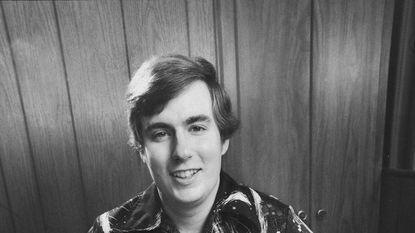

In the mid-1980s, as investigators were scrambling to make sense of the string of explosive packages being delivered across the U.S. by the Unabomber, a series of package bombs detonated in Salt Lake City, killing two and injuring two more. The crimes weren't the work of Ted Kaczynski, but one of the injured bomb victims, Mark Hofmann. Hofmann's scandalous story is the subject of new Netflix docuseries Murder Among the Mormons, which devotes its three episodes to exploring Hofmann's trajectory from lauded collector of rare Mormon church documents to murderous bomber and criminal fraudster.
To recap: After being raised in a staunchly Mormon household, Hofmann became disillusioned with the religion and began using forgery skills developed in his youth to create documents that seemingly revealed previously unknown information about the formation of the Church of Jesus Christ of Latter-day Saints, much of which was embarrassing and potentially damaging to the church's reputation (the Salamander Letter, anyone?). After successfully duping church leaders and historians, Hofmann ramped up his work and expanded into creating counterfeit documents outside the purview of the church. Despite his successes, however, Hofmann eventually found himself deeply in debt and unable to deliver some of the rare documents he had promised to various buyers—so he decided to send homemade bombs to some of those buyers. Naturally.
When one of the bombs detonated in Hofmann's car and eyewitness accounts began pointing his way, his whole scheme began to unravel. Here's what happened to Hofmann, and where he is now.
The bomb in Hofmann's car seemed immediately suspicious to investigators—since the first two bombs had been sent to well-known rare document collectors and Hofmann was far less prominent—and he seemed even more guilty when a jacket was found in his possession that matched an eyewitness description of the deliverer of the first bomb. It took months, however, for investigators to actually pin the October 1985 bombings on Hofmann; he was only arrested in January 1986 after they had finally unraveled his massive web of fraud and forgery.
Among the most damning pieces of evidence were the discovery of the engraving plate that Hofmann had used to create what he claimed was an original copy of the "Oath of a Freeman," believed to be the first document printed in the U.S. in the 1630s; and renowned forensic examiner George Throckmorton's analysis of several documents sold by Hofmann, which were found to be written in ink inauthentic to the documents' purported time periods.
Due largely to this and other findings by Throckmorton, Hofmann was arrested in early 1986 and charged with 27 counts covering first-degree murder, bomb construction and delivery, and various forms of fraud.
Side note: Despite those discoveries, not all of Hofmann's forgeries were immediately recovered and debunked, as they had been sold and traded across a vast network of collectors and buyers over the course of several years. It wasn't until 12 years after the bombings, for instance, that a poem attributed to Emily Dickinson was finally revealed to actually be a Hofmann original.
Stay In The Know
Marie Claire email subscribers get intel on fashion and beauty trends, hot-off-the-press celebrity news, and more. Sign up here.
In a controversial move on the part of the prosecutors, there wasn't actually a trial. Hofmann was offered a plea bargain by which he pled guilty to two counts of second-degree murder and two counts of theft by deception in January 1987, a year after his arrest, and was able to avoid a trial during which he could've faced the death penalty. Instead, the then-32-year-old was sentenced to five years to life, with the judge recommending that he never be released, the AP reported at the time.
He was taken to the maximum-security Utah State Prison in Draper the same day of his plea bargain and sentencing, after which a "letter of regret" he had written was reportedly delivered to the families of his victims. Many of them weren't convinced: "I think he's incapable of being sorry. I think he wrote the letter to appease his parents," Jean Gorton, sister of bombing victim Kathleen Sheets, told the AP.
A year after his sentencing, Hofmann wrote a letter to the Utah Board of Pardons and Parole detailing his childhood fascination with forgery, his attempts to keep from being exposed as a fraud by planting the bombs, and his claim that the bomb found in his car was actually meant for himself, rather than an unknown third victim. He also testified in person to the parole board, after which they reportedly swiftly ordered that he spend the rest of his life behind bars without the possibility of parole.
Hofmann was also subsequently excommunicated by the LDS church, and his wife Doralee filed for divorce in August 1988. Most recently, in late 2015, after nearly 30 years in jail, Hofmann was transferred from maximum security to a lower-security cell in the state prison in Gunnison, Utah. The move represented authorities' assessment that he is no longer a danger to himself or those around him, and reportedly grants him more recreation time and greater access to other inmates.
Andrea Park is a Chicago-based writer and reporter with a near-encyclopedic knowledge of the extended Kardashian-Jenner kingdom, early 2000s rom-coms and celebrity book club selections. She graduated from the Columbia School of Journalism in 2017 and has also written for W, Brides, Glamour, Women's Health, People and more.
-
 Your Makeup Won't Budge With These Setting Sprays
Your Makeup Won't Budge With These Setting SpraysPrepare for 12-hour wear.
By Sophia Vilensky Published
-
 Prince William Single-Handedly Planned His and Kate Middleton’s Romantic Honeymoon
Prince William Single-Handedly Planned His and Kate Middleton’s Romantic HoneymoonKate had no idea where they were headed on their two week luxurious break from reality until after their 2011 wedding.
By Rachel Burchfield Published
-
 Bitten Lips Took Center Stage at Dior Fall 2024 Show
Bitten Lips Took Center Stage at Dior Fall 2024 ShowModels at the Dior Fall 2024 show paired bitten lips with bare skin, a beauty trend that will take precedence this season.
By Deena Campbell Published
-
 The Best Bollywood Movies of 2023 (So Far)
The Best Bollywood Movies of 2023 (So Far)Including one that just might fill the Riverdale-shaped hole in your heart.
By Andrea Park Published
-
 ‘Bachelor in Paradise’ 2023: Everything We Know
‘Bachelor in Paradise’ 2023: Everything We KnowCue up Mike Reno and Ann Wilson’s “Almost Paradise."
By Andrea Park Last updated
-
 Who Is Gerry Turner, the ‘Golden Bachelor’?
Who Is Gerry Turner, the ‘Golden Bachelor’?The Indiana native is the first senior citizen to join Bachelor Nation.
By Andrea Park Last updated
-
 ‘Virgin River’ Season 6: Everything We Know
‘Virgin River’ Season 6: Everything We KnowHere's everything we know on the upcoming episodes.
By Andrea Park Last updated
-
 Kim Cattrall Didn't See or Speak to Her Costars When Filming 'And Just Like That' Cameo
Kim Cattrall Didn't See or Speak to Her Costars When Filming 'And Just Like That' CameoThat's some type of commitment.
By Iris Goldsztajn Published
-
 The 60 Best K-Dramas You'll Be Completely Hooked On
The 60 Best K-Dramas You'll Be Completely Hooked OnWait, how is it already 2 a.m.?
By Quinci LeGardye Last updated
-
 Selena Gomez Revealed Meryl Streep Is Joining 'Only Murders in the Building' Season 3
Selena Gomez Revealed Meryl Streep Is Joining 'Only Murders in the Building' Season 3Fans are losing it.
By Iris Goldsztajn Published
-
 The 60 Best Musical Movies of All Time
The 60 Best Musical Movies of All TimeAll the dance numbers! All the show tunes!
By Amanda Mitchell Last updated